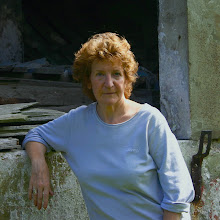Henry Darger reminds us that art is not about selling a
painting to match the couch – it’s about keeping your spirit alive no matter
how harsh your circumstances. He’s
probably the greatest self-taught “outsider”
artist and the little room he retreated to at the end of his workday is perfectly
preserved in the Intuit Center for Intuitive and Outsider Art in Chicago at 756 N. Milwaukee Avenue.
I
am visiting Chicago this week so I have some time to catch up on Darger’s
story. Born in 1892, his mother died when he was four and his crippled and
impoverished father was taken to live in a Catholic Mission home. Soon after, Darger
was institutionalized in the Illinois Asylum for
Feeble-Minded Children. "Little Henry's heart was not in the right place."
He suffered from Tourette’s Syndrome, probable sexual abuse, forced labor and
severe punishments. He finally escaped at the age of 16 and returned to
Chicago. With the help of his godmother, he found menial employment in a
Catholic hospital where he worked and supported himself until his retirement in
1963. Except for a brief stint in the U.S.
Army during World
War I,
his life followed a rigid pattern: he attended daily Mass, frequently
returning for as many as five services; he collected and saved a bewildering
array of trash from the streets. His dress was shabby, although he attempted to
keep his clothes clean and mended. He was largely solitary; his one close friend,
William Schloeder, was like minded on the subject of protecting abused and
neglected children, and the pair proposed founding a "Children's
Protective Society", which would put such children up for adoption to
loving families. Schloeder left Chicago sometime in the mid-1930s, but he and
Darger stayed in touch through letters until Schloeder's death in 1959. In 1930,
Darger settled into a second-floor room on Chicago's North Side, at 851 W.
Webster Avenue. It was in this room, over the course of 43 years, that Darger produced
his breathtaking,
disturbing, monumental artwork and writings. His works including “In the Realms
of the Unreal” detail a complex fantasy world filled with idyllic beauty and
hellish violence.
Darger’s secret life’s work was found by his
landlord shortly after he moved out of his apartment and into a nursing home. Darger died in 1973 and is buried in All
Saints Cemetery in Des Plaines, Illinois, in a plot called
"The Old People of the Little Sisters of the Poor Plot". Darger's
headstone is inscribed "Artist" and "Protector of
Children". Darger once wrote of children's right "to play, to be
happy, and to dream, the right to normal sleep of the night's season, the right
to an education, that we may have an equality of opportunity for developing all
that are in us of mind and heart."




